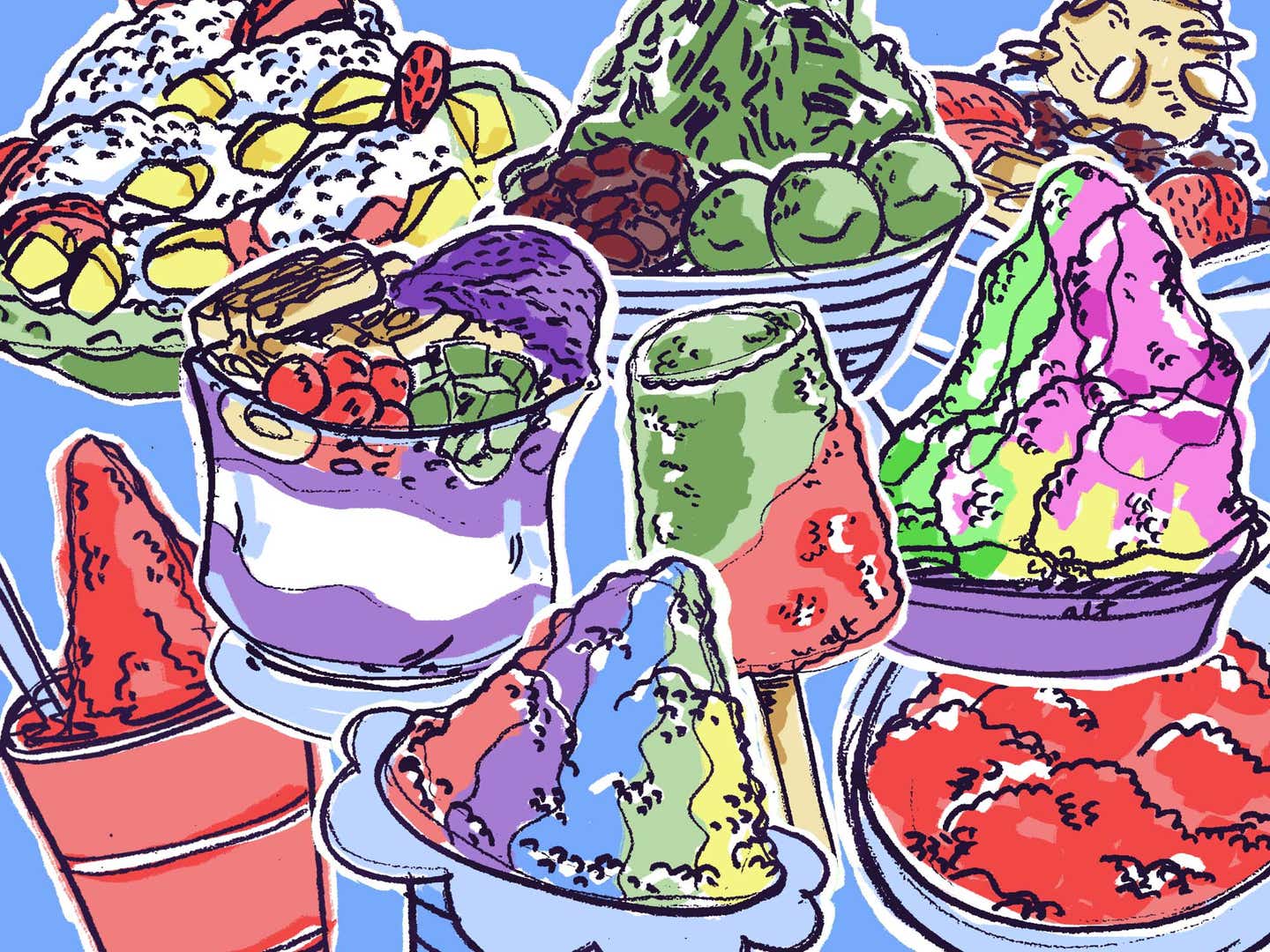
The Illustrated Global Guide to Shaved Ice
How to sort the world’s halo-halo from its bao bing
Growing up outside of Manila, my mom sold halo-halo. Any time she wanted to earn extra money, she'd sprint to the market and shell out a few pesos for a slab of ice—an unwieldy rectangular hunk, like the ones manipulated so musically in the beginning of Frozen. Resting it in a box lined with rice husks to slow the inevitable puddle, she'd drag her chilly acquisition back, setting up impromptu shop in front of her aunt's sari-sari convenience store—no permits necessary. "In the Philippines," she happily points out, "there's no such thing as zoning."
Shop customers, relatives and friends, passersby sweating down the street—in April and May, the two hotter-than-hell months on the Philippine calendar, every ambulatory human is a halo-halo mark. The second someone placed an order, mom would chisel a hunk off the master block and work it over with a heavy steel hand scraper, gussying up the tropical snow with evaporated milk, sweet beans, ube, coconut and diced plantains. All that gets mixed together as it’s eaten, a time-sensitive action that gives halo-halo its name. It was her lemonade stand, cooling off one of the hottest populaces in the world for mere pocket change.
Growing up outside Baltimore, I ate snowballs. Any time I wanted a core-temp–cooling blast of sugar, I'd head to the clapboard shed in the parking lot of the gas station near my parents' house. (That gas station has since become a crab shack—a most welcome Maryland fate.) The stand's employees, usually stoned teenagers in reversible lacrosse pinnies, would pack squeaky styrofoam cups with cold stuff crushed by a whirring appliance. They'd finish each snowball with pumps of sweetened syrup—"egg custard," a vivid Protestant-orange flavor that tastes a little like flan, is a local favorite—and spoonfuls of sticky Marshmallow Fluff.
A General Theory of Shaved Ice
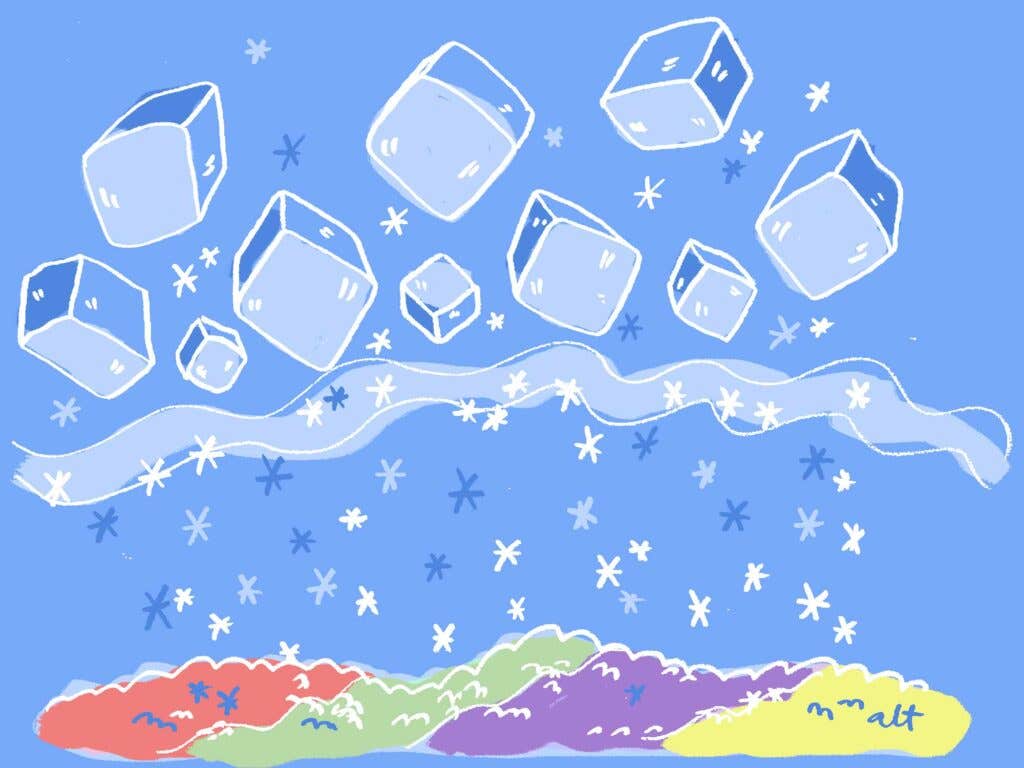
As incredibly different as these treats are, they are kindred in two areas. The first is their utility: They’re cheap and meant to chill you out, from the year’s opening heat wave through to the waning days of a stubborn summer. The second is their very temporary canvas: shaved ice.
Traced back thousands of years, shaved ice is among the most versatile dessert formats in the world, one that thrives, naturally, in oppressively hot climates. The parlance of savvy street vendors and push-cart operators, it’s a language that takes on the dialectical quirks of a culture, absorbing indigenous influences in its quick-melting midst. Though nuances in preparation, toppings and presentation distinguish one contemporary shaved ice from another, there is enough overlap to suggest there is an ur-shaved ice buried somewhere deep in antiquity. Identifying and heralding the inventor of this technique, of course, is trickier and stickier than a squeeze bottle filled with condensed milk.
Using snow to chill food and drink is a very old concept—it’s referenced in the Book of Proverbs and associated with Alexander the Great and the royal courts of feudal China. Academic credit for marrying this concept with dessert, however, is most frequently bestowed upon the emperor Nero. Though he’s remembered best for rocking out on his fiddle while Rome burned to the ground in 64 A.D.—a tall tale scholars reminds us never happened, as the fiddle wasn’t invented yet—Nero was also perhaps the food-geekiest of all Roman leaders, balancing his sickening disregard for the human condition with some super-rad culinary innovations.
Nero, believed to have seized control of Rome after his mother, Agrippina, murdered her sitting-ruler husband Claudius with a plate of poisoned morels (thx mom!), established mammoth ice houses throughout Rome. Their product served a functional purpose in wet markets and the like, but Nero also loved to fuss with it at his notoriously baller banquets, which allegedly ran straight from noon to midnight. Extremely particular about the temperature of his wine, Nero always had blocks of ice on hand, according to the writings of Pliny the Elder; shavings would sometimes be sweetened with fresh fruits and honey and offered to guests.
Around the World in Sugary Snow
In addition to formative mentions of ice manipulation popping up in ancient China, there is also a later documented association with the Heian period of Japanese history, which ran from 794 A.D. to the tail end of the 12th century. Courtiers enjoyed shaved ice as a delicacy; various stems and leaves were used to lightly flavor it. This latter rendition is worth noting, as the Oxford Companion to Sugar and Sweets and other sources infer that Japanese emigration patterns had a huge influence on the spread of shaved ice throughout the modern world.
There are citations of shaved ice spread throughout pre-20th century civilizations, from the Mughal rulers of the Indian subcontinent to French and Italian confectioners serving sweet-toothed aristocrats.
There is plenty of overlap with the history of ice cream, as well as some glaring holes in geographic logic that even the most erudite food scholars have trouble explaining. Regardless, it’s fair to say that any nation serving shaved ice has made efforts to make it its own—it’s easy to ignore a historical morass when you’ve got sweet melting mess dribbling down your chin.
China and Taiwan: Bao Bing
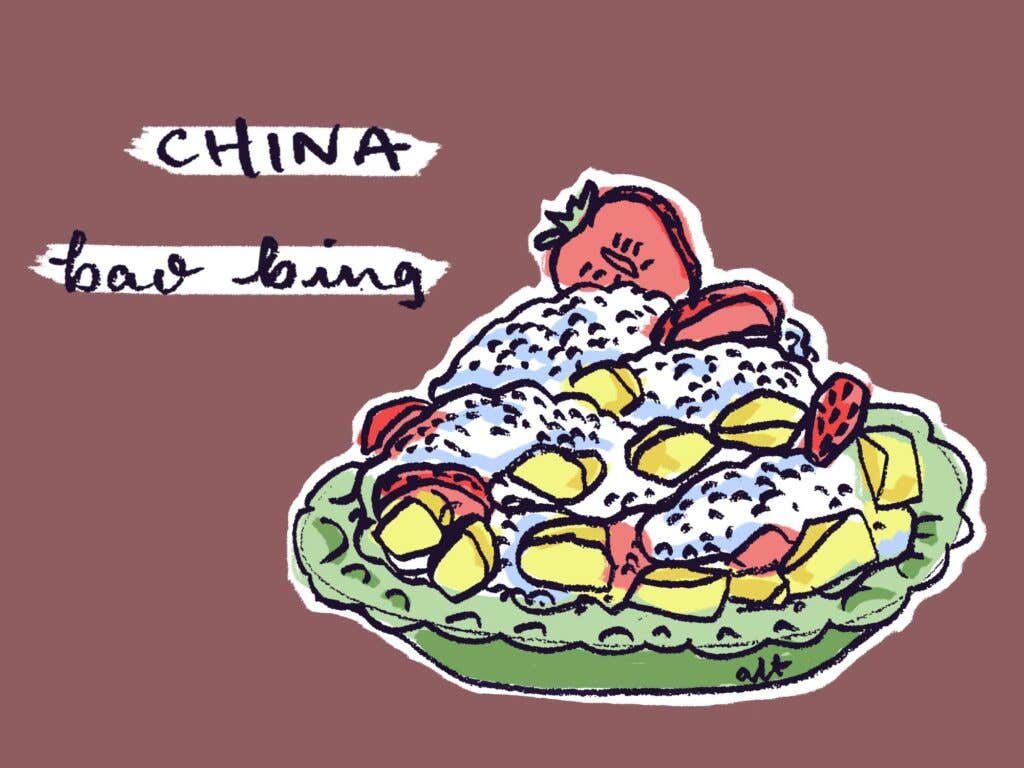
One of the oldest styles of shaved ice in recorded history—word of the Chinese using ice for culinary and commercial means goes back to 1100 BC—bao bing serves as a reasonable default for examining all-things shaved ice. Whether it's produced with an old-fashioned metal hand tool or by a pricey machine that looks like a first cousin of the TARDIS, it is scraped to a specific consistency: not finely pulverized to resemble sorbet, but not coarsely crushed like an American sno-cone, either. This in-between texture succeeds in holding sauces and syrups in suspended animation, as opposed to them wicking off the top and draining to the bottom.
Syrups made from fresh fruit, condensed and evaporated milks, all manner of sweet beans, and fresh-cut mango, coconut, lychee and strawberry are common bao bing additions. The dessert is a particular institution in Taiwan, where it is known as chua bing. Shops like Taiwan Number 1 Milk King, in Taipei, have been around for decades, serving their traditional bings topped any way you like them on shallow lipped plates. More modern Taiwanese ice shops, meanwhile, have taken inspiration from the frozen yogurt game. In addition to using pre-fab frozen blocks already infused with the customer's flavor of choice (this finer-shaved subcategory is sometimes called "snow" as opposed to chewier old-school shaved ice), they'll also extend the toppings bar to include Jelly Bellys, Pocky, and sweet breakfast cereals.
Japan: Kakigori
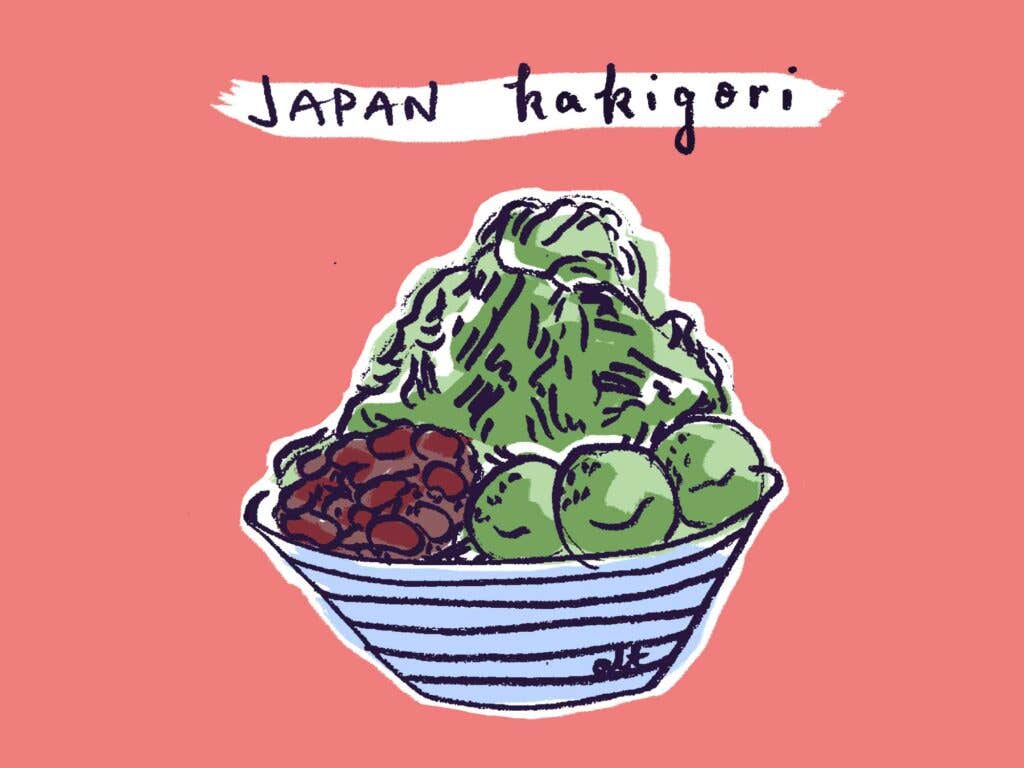
Though there is evidence of togashi, a category of doughy Chinese-influenced desserts, growing in popularity in Japan between the seventh and ninth centuries A.D., it’s difficult to say definitively whether or not shaved ice was brought to Japan from China by traveling envoys or the other way around. Regardless, kakigori shares some similarities with its Chinese counterpart. Closely linked with summer consumption more so than enjoy-them-anytime counterparts such as ice cream or froyo, it’s a snow-style shaved ice that comes drizzled with a wide variety of neon syrups.
The ice here, however, comes packed high, creating a dramatic volcanic visual effect. Toppings and flavor combos vary by region—Ujikintoki, named for the tea-producing city and topped with its requisite matcha, mochi, and sweet azuki beans, is a popular rendition that's gone national.
Korea: Patbingsu
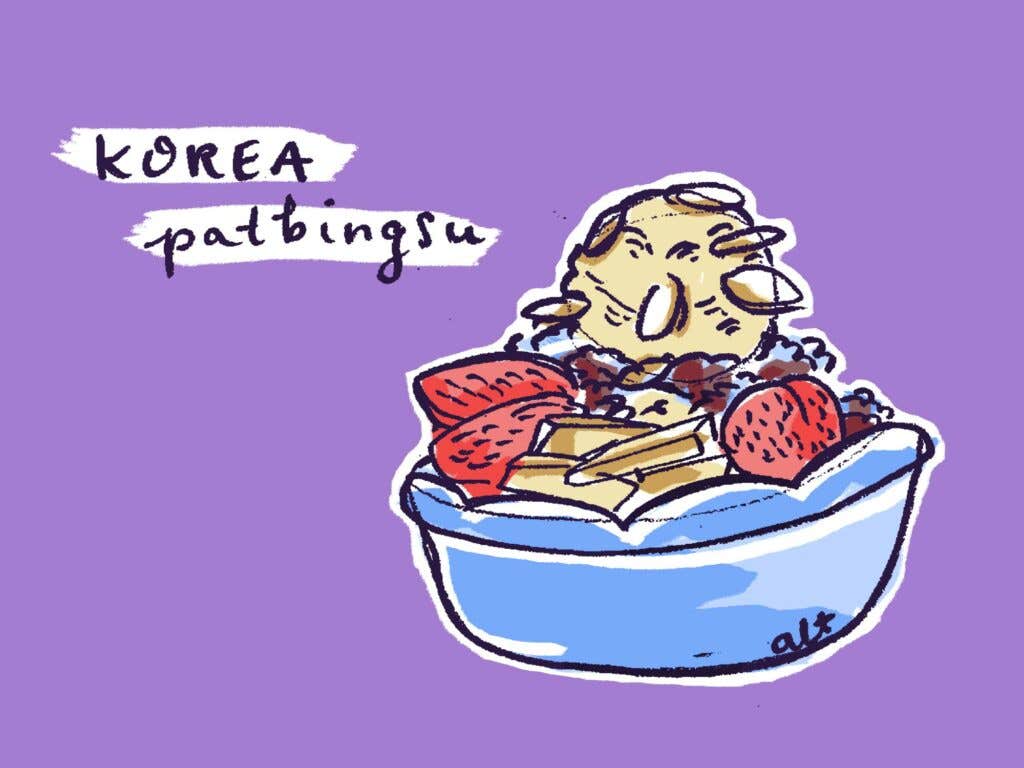
Variations on shaved ice have been consumed in Korea since the rule of the Joseon Dynasty (1392 to 1897). The “pat” in “patbingsu” refers to the red bean paste so ubiquitous in East Asia; some claim that Koreans were the first to incorporate this ingredient into shaved ice.
Eaten most frequently during Korea's sweltering months, the dish is similar in makeup and construction to its East Asian counterparts. Most bowls can feed two easily; jangpan bingsu, an extra-large format, is meant to be split among a large group.
Malaysia and Singapore: Ais Kacang
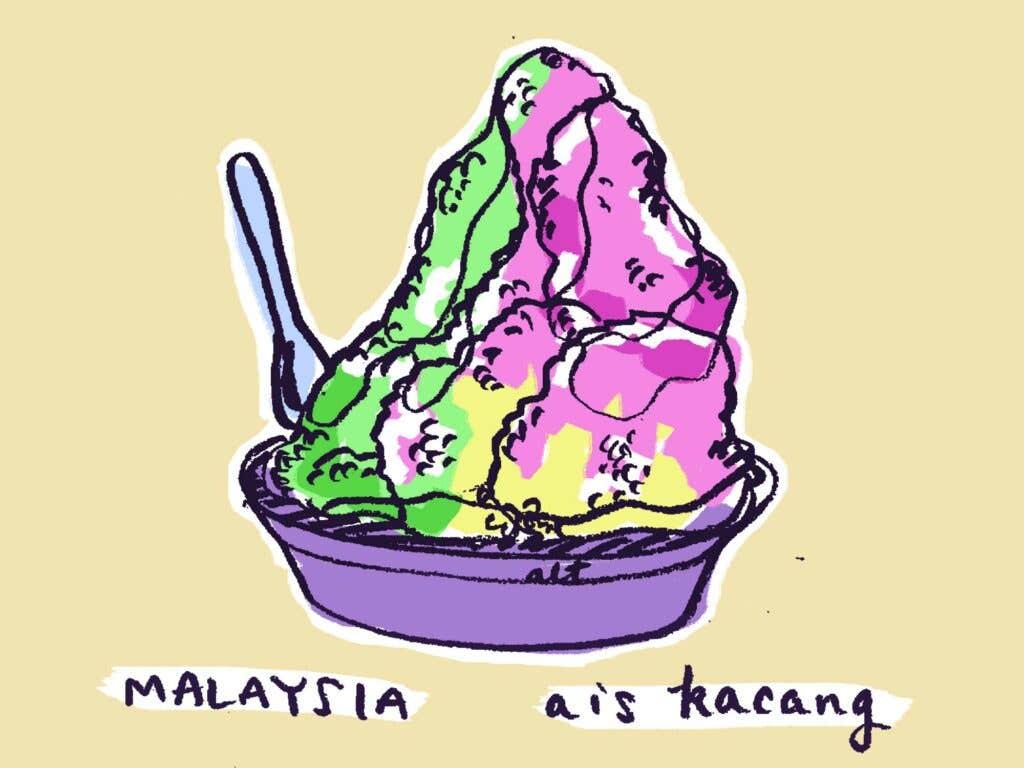
Sometimes called air batu campar (“mixed ice”), or ABC for short, ais kacang is Malaysia’s best-known shaved ice. “Kacang” means nuts, so peanuts are a frequent inclusion; on top of the requisite red beans and evaporated milk, additions can include fresh fruit, cincau (grass jelly), red tapioca pearls, palm seeds, rambutan, gula melaka (coconut palm sugar) and more regional ingredients.
Comparable renditions are served in different countries throughout Southeast Asia—in Indonesia there’s es campur and its coconut milk-based companion, es doger; nam kang sai keeps eaters cool in Thailand.
Philippines: Halo-halo
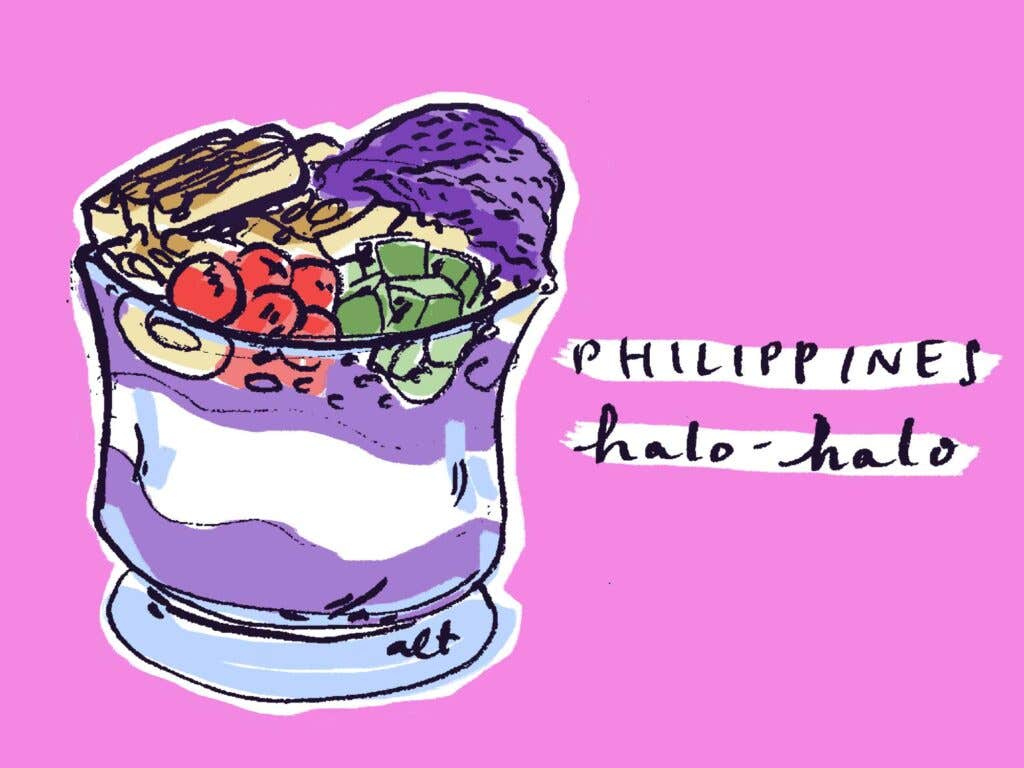
The Filipino shaved ice features many characteristics common to Southeast Asian shaved ice, in terms of base ingredients and composition. Halo-halo stands out, however, for the sheer audacity of its appearance. Lit up with bright yellows, purples, reds and greens, halo-halo is the Baz Luhrmann of shaved ice: colorful, loud, and sometimes odd (see: cheese ice cream), but always pretty.
India: Chuski
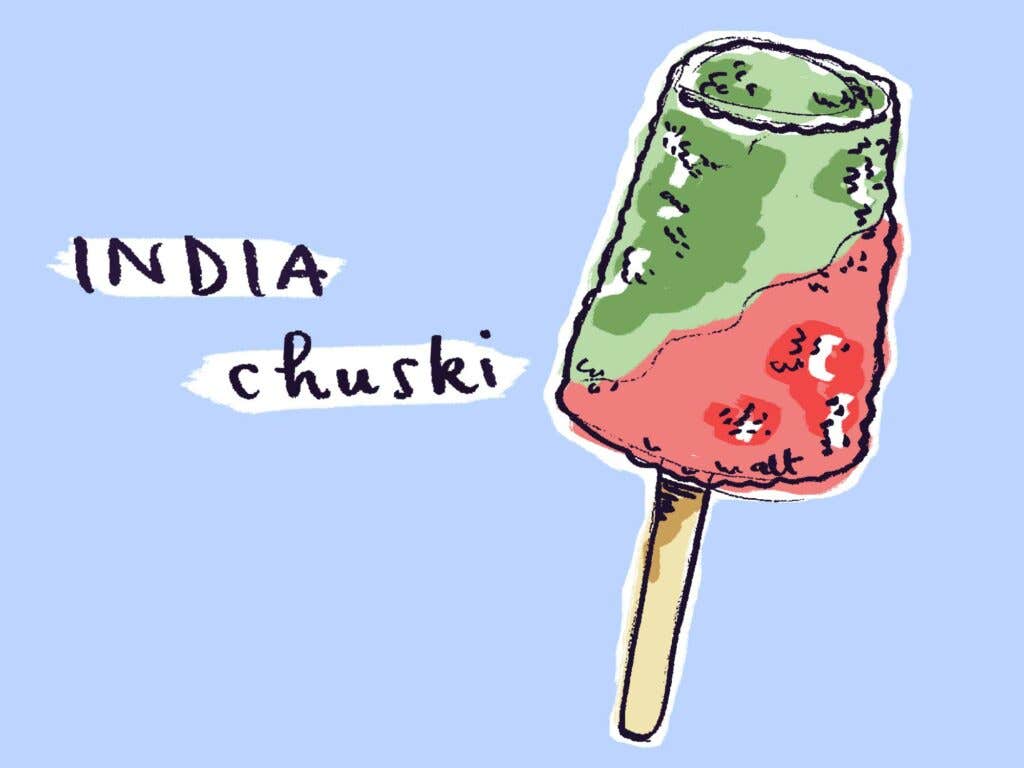
To prepare this Indian roadside confection, vendors push coarsely shaved ice down into a cup, inserting a wooden handle for tidy eating. The makeshift popsicles, which quickly take to the shape of their container, are then flavored with fruit syrups—including kiwi, mango, and guava—which are poured over top or applied via dunking.
Italy: Granita
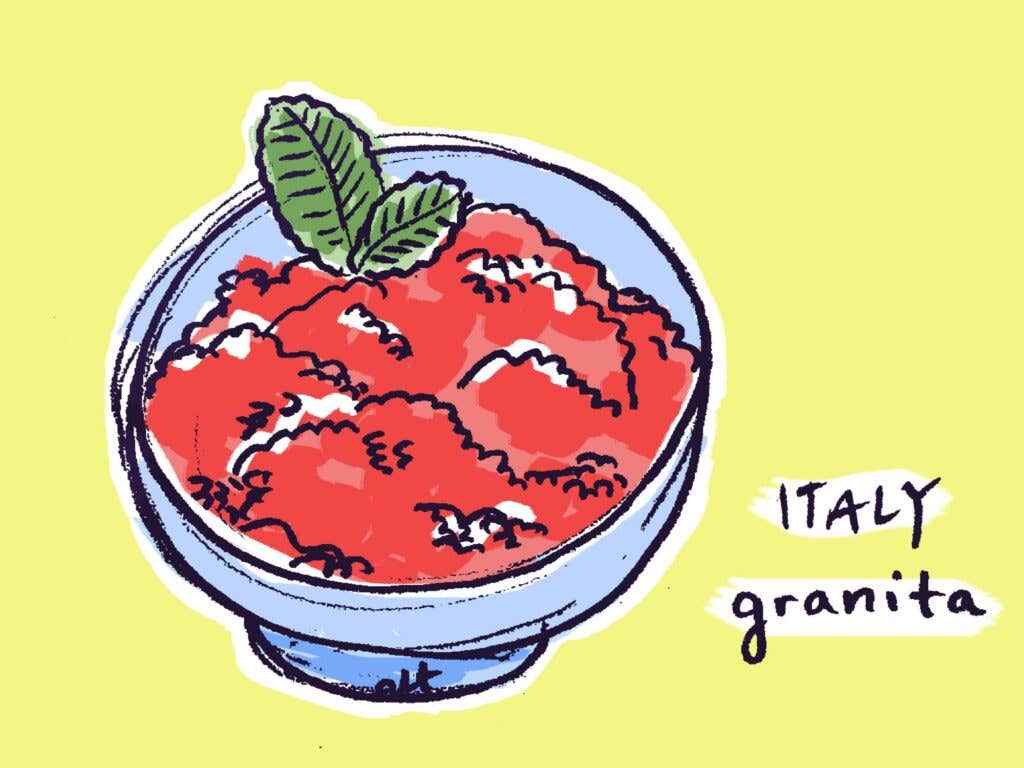
Nero set the groundwork for the development of ices in Western Europe, refreshers that were typically positioned at the very end of an opulent banquet. Over the years, granita became fashionable as a mid-course palate cleanser, and sometimes even in savory applications. Though not technically shaved on-demand, ices, a combination of water, sugar and flavored liquid frozen slowly to achieve a granular texture, served a similar refreshing purpose.
Recipes and musings on ices take up an entire chapter of Auguste Escoffier’s Le Guide Culinaire, where he is not exactly subtle about France’s contributions to the form. “Though the Neapolitans have deservedly maintained their reputation as authorities in this matter,” he wrote, “to French chefs, certainly, is due the credit of those innovations which have perfected this important branch of dietetic science." (Translation: the Italians made it a hot line; Escoffier made it a hot song.)
Hawaii: Shave Ice
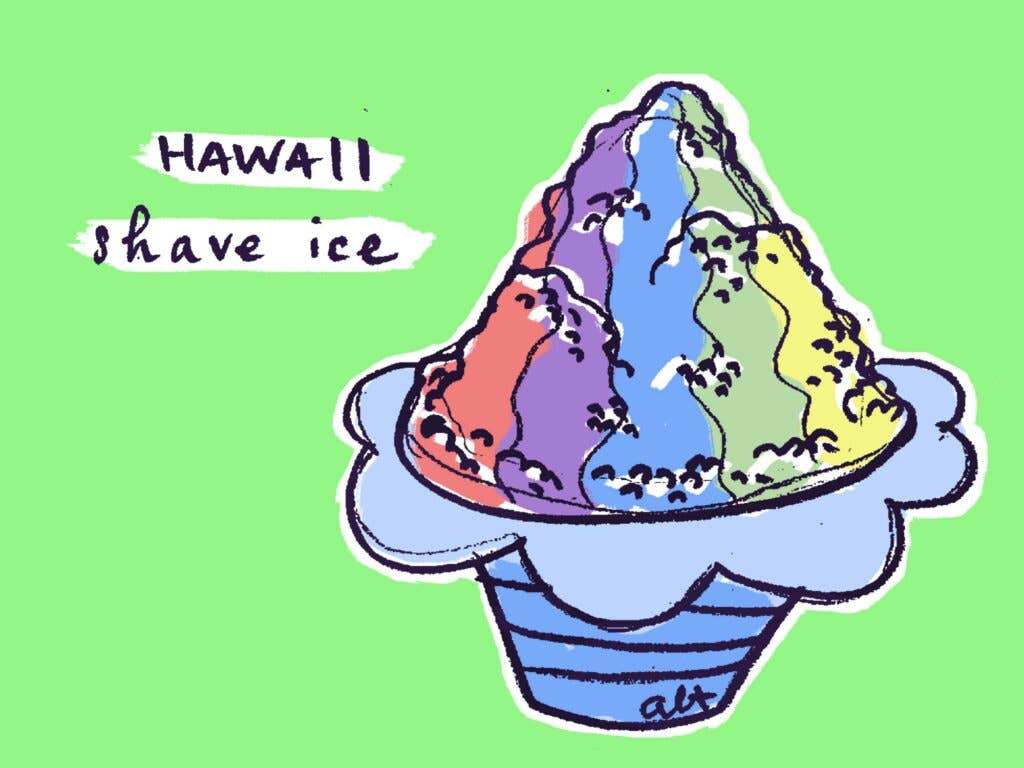
For starters: it’s not shaved ice. Shave ice, in proper Pidgin vernacular, is thought to have arrived in Hawaii by way of the kakigori-eating Japanese sugar farmers who began emigrating to the islands in the mid-1800s after a succession of poor growing seasons.
Flaky Hawaiian shave ice comes mounded in a cone or bowl, colored with multiple syrups (lilikoi, or yellow passion fruit; Hawaiian pineapple; li hing mui, or salty plum) and often crowned with a "snowcap" of condensed milk. President Obama's favorite shave ice spot is Island Snow in Kailua.
Puerto Rico: Piraguas
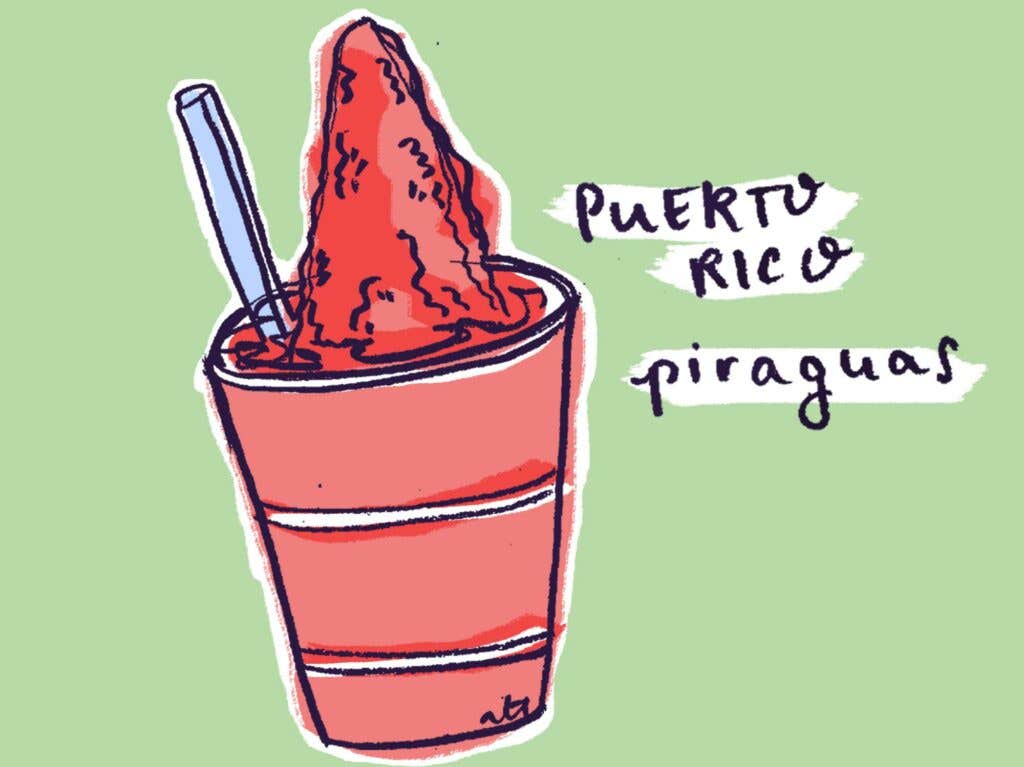
Puerto Rico’s native shaved ice is a throwback. Typically the domain of street hawkers, the conical piragua (a portmanteau of the Spanish words for pyramid and water) is a straightforward treat—hand-shaved ice, accompanied by tropical syrups like guava, tamarind or coconut. Variations on this format can be found throughout Central and South Americas; Colombian, Venezuelan, Cuban and Dominican riffs can feature condensed milk or dulce de leche in addition to the fruit.
Keep Reading
Continue to Next Story










